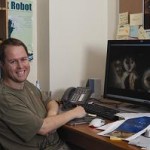Legend of the Guardians: Art director Grant Freckelton
 To celebrate the release of Legend of the Guardians: The Owls of Ga’Hoole, Encore will publish a series of interviews with the key creatives behind the animated film.
To celebrate the release of Legend of the Guardians: The Owls of Ga’Hoole, Encore will publish a series of interviews with the key creatives behind the animated film.
Today we start with art director Grant Freckelton, who had to draw the line between visual realism and storytelling to create the owl world of the film.
Where do you draw the line between photorealism and a sense of artistic interpretation of this world?
Serving the story is more important than being a slave to realism, so I believe strict photorealism is not as important as creating dramatic imagery and eliciting and emotional response from the audience. When it comes down to it, we have to start reinterpreting reality the moment we stick a helmet on an owl and expect it to talk.


Dear Zachary
I recently saw your Legends and Guardians Owls of Ga’hoole. As well as my sister, her friend and his family. We all greatly enjoyed the movie, we thought it was one of the best films we have ever seen. My favorite character was Soren of course, my least favorite was Nyra. I would so much like to know if there is going to be a second movie. If not I would like to encourage you to continue this epic film series
Hi I have been reading about owls for the better part of my life. And I loved your art work. It was absolutly incredible and almost perfect. However your end credit art work enticed me more than the movie believe it or not. I am trying to find a particular picture from the credits. I am going back to see your movie again with my fiance’s 5 year old brother. But I would like to get a copy of it if u don’t mind. Your artistry is amazing and I am no where near an artist. And please make a second movie.
I love the movie and hope for more! I really was hoping for action figures other than beanie babies.Any chances?
“Legend of the Guardians” was absolutely breathtaking, very well done. I’ve already seen it three times since it has been out. The whole art design of the film is what attracted me initially, I’ve never seen a more beautiful animated film. A sequel is definitely in order, I say. Though I’d also love to see a book showcasing all of the conceptual drawings and other development work.
plzzzzzzzzzzzzz make a seconddddddddddd movieeeeeeeeeeeeee
Dear Mr. Snyder,
Perhaps, one of the biggest questions I have is, why did you move so far away from the actual storyline? I understand that lots of people have not read the books, and it WAS a great movie for them, but could have just been great visuals for those who have read the books. Now, tell your animation crew that they did the most fantastic job I’ve seen yet in the 3D animations department, and I’m sure you know that, and that you’ve already told them so. Don’t get me wrong when I say that the storyline was so far away, it was a delightful movie indeed!
My second question is, are you making any other movies for this series? You’ve left all of us with questions that should be answered.
Sincerely,
Alyssa Gnos